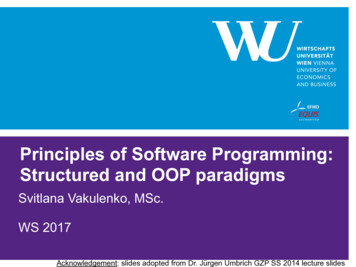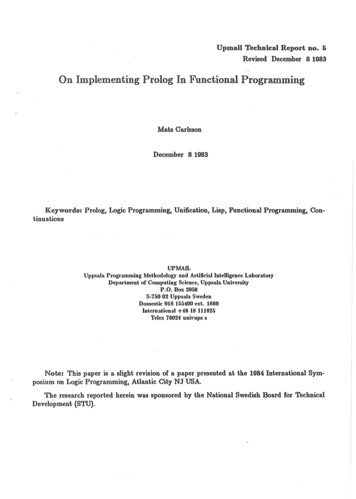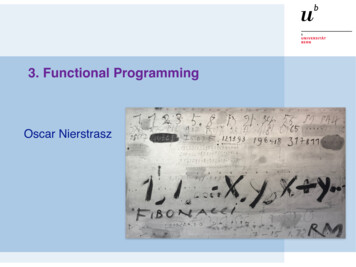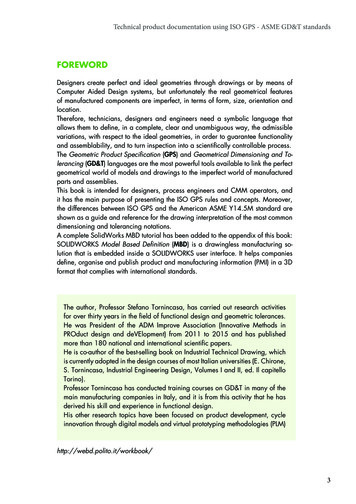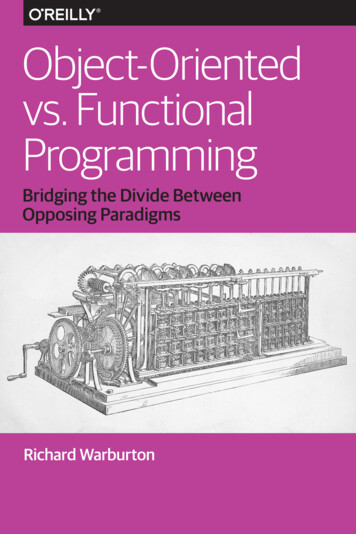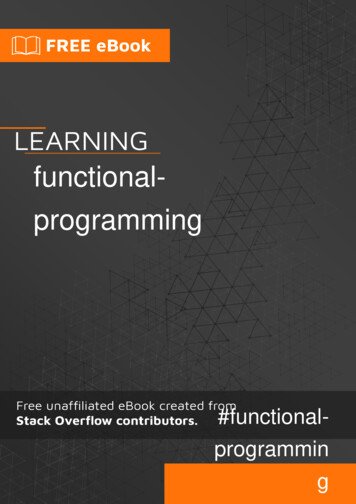
Transcription
functionalprogramming#functionalprogramming
Table of ContentsAbout1Chapter 1: Getting started with functional-programming2Remarks2Examples2Pure functions2Higher-order functions3Currying4Immutability5Chapter 2: Loops by Recursive and Tail Recursive Functions7Introduction7Examples7non-recursive (where immutability isn't a concern)7recursive to rescue7tail recursive to optimize7Credits9
AboutYou can share this PDF with anyone you feel could benefit from it, downloaded the latest versionfrom: functional-programmingIt is an unofficial and free functional-programming ebook created for educational purposes. All thecontent is extracted from Stack Overflow Documentation, which is written by many hardworkingindividuals at Stack Overflow. It is neither affiliated with Stack Overflow nor official functionalprogramming.The content is released under Creative Commons BY-SA, and the list of contributors to eachchapter are provided in the credits section at the end of this book. Images may be copyright oftheir respective owners unless otherwise specified. All trademarks and registered trademarks arethe property of their respective company owners.Use the content presented in this book at your own risk; it is not guaranteed to be correct noraccurate, please send your feedback and corrections to info@zzzprojects.comhttps://riptutorial.com/1
Chapter 1: Getting started with functionalprogrammingRemarksFunctional programming is a programming paradigm which models computations (and thusprograms) as the evaluation of mathematical functions. It has its roots in lambda calculus, whichwas developed by Alonzo Church in his research on computability.Functional programming has some interesting concepts: Higher Order functionsPurityRecursionLazinessReferential TransparencyCurryingFunctorsMonadsMemoization & Tail-call OptimizationFunctional Unit TestingSome examples of functional programming languages are Lisp, Haskell, Scala and Clojure, butalso other languages, like Python, R and Javascript allow to write (parts of) your programs in afunctional style. Even in Java, functional programming has found its place with LambdaExpressions and the Stream API which were introduced in Java 8.ExamplesPure functionsPure functions are self-contained, and have no side effects. Given the same set of inputs, a purefunction will always return the same output value.The following function is pure:function pure(data) {return data.total 3;}However, this function is not pure as it modifies an external variable:function impure(data) {data.total 3;return data.total;https://riptutorial.com/2
}Example:data {total: 6};pure(data);// outputs: 9impure(data); // outputs: 9 (but now data.total has changed)impure(data); // outputs: 12Higher-order functionsHigher-order functions take other functions as arguments and/or return them as results. They formthe building blocks of functional programming. Most functional languages have some form of filterfunction, for example. This is a higher-order function, taking a list and a predicate (function thatreturns true or false) as arguments.Functions that do neither of these are often referred to as first-orderfunctions.function validate(number,predicate) {if (predicate) {// Is Predicate definedreturn predicate(number);}return false;}Here "predicate" is a function that will test for some condition involving its arguments and returntrue or false.An example call for the above is:validate(someNumber, function(arg) {return arg % 10 0;});A common requirement is to add numbers within a range. By using higher-order functions we canextend this basic capability, applying a transformation function on each number before including itin the sum.You want to add all integers within a given range (using Scala)def sumOfInts(a: Int, b: Int): Int {if(a b) 0else a sumOfInts(a 1, b)}You want to add squares of all integers within a given rangehttps://riptutorial.com/3
def square(a: Int): Int a * adef sumOfSquares(a: Int, b: Int): Int {if(a b) 0else square(a) sumOfSquares(a 1, b)}Notice these things have 1 thing in common, that you want to apply a function on each argumentand then add them.Lets create a higher-order function to do both:def sumHOF(f: Int Int, a: Int, b: Int): Int {if(a b) 0else f(a) sumHOF(f, a 1, b)}You can call it like this:def identity(a: Int): Int adef square(a: Int): Int a * aNotice that sumOfInts and sumOfSquare can be defined as:def sumOfInts(a: Int, b: Int): Int sumHOF(identity, a, b)def sumOfSquares(a: Int, b: Int): Int sumHOF(square, a, b)As you can see from this simple example, higher-order functions provide more generalizedsolutions and reducing code duplication.I have used Scala By Example - by Martin Odersky as a reference.CurryingCurrying is the process of transforming a function that takes multiple arguments into a sequence offunctions that each has only a single parameter. Currying is related to, but not the same as, partialapplication.Let's consider the following function in JavaScript:var add (x, y) x yWe can use the definition of currying to rewrite the add function:var add x y x yThis new version takes a single parameter, x, and returns a function that takes a single parameter,y, which will ultimately return the result of adding x and y.https://riptutorial.com/4
var add5 add(5)var fifteen add5(10) // fifteen 15Another example is when we have the following functions that put brackets around strings:var generalBracket (prefix, str, suffix) prefix str suffixNow, every time we use generalBracket we have to pass in the brackets:var bracketedJim generalBracket("{", "Jim", "}") // "{Jim}"var doubleBracketedJim generalBracket("{{", "Jim", "}}") // "{{Jim}}"Besides, if we pass in the strings that are not brackets, our function still return a wrong result. Let'sfix that:var generalBracket (prefix, suffix) str prefix str suffixvar bracket generalBracket("{", "}")var doubleBracket generalBracket("{{", "}}")Notice that both bracket and doubleBracket are now functions waiting for their final parameter:var bracketedJim bracket("Jim") // "{Jim}"var doubleBracketedJim doubleBracket("Jim") // "{{Jim}}"ImmutabilityIn traditional object-oriented languages, xFunctional Programming, it's illegal. x 1is a simple and legal expression. But inVariables don't exist in Functional Programming. Stored values are still called variables onlybecause of history. In fact, they are constants. Once x takes a value, it's that value for life.So, if a variable is a constant, then how can we change its value?Functional Programming deals with changes to values in a record by making a copy of the recordwith the values changed.For example, instead of doing:var numbers [1, 2, 3];numbers[0] 1; // numbers [2, 2, 3];You do:var numbers [1, 2, 3];var newNumbers numbers.map(function(number) {if (numbers.indexOf(number) 0)return number 1return number});https://riptutorial.com/5
console.log(newNumbers) // prints [2, 2, 3]And there are no loops in Functional Programming. We use recursion or higher-order functionslike map, filter and reduce to avoid looping.Let's create a simple loop in JavaScript:var acc 0;for (var i 1; i 10; i)acc i;console.log(acc); // prints 55We can still do better by changing acc's lifetime from global to local:function sumRange(start, end, acc) {if (start end)return acc;return sumRange(start 1, end, acc start)}console.log(sumRange(1, 10, 0)); // 55No variables or loops mean simpler, safer and more readable code (especially when debugging ortesting - you don't need to worry about the value of x after a number of statements, it will neverchange).Read Getting started with functional-programming online: https://riptutorial.com/6
Chapter 2: Loops by Recursive and TailRecursive FunctionsIntroductionAs you already know, for the sake of immutability you can't process data using for loops and whileloops. So we have recursive functions to rescue.Examplesnon-recursive (where immutability isn't a concern)function sum(numbers) {var total 0;for (var i numbers.length - 1; i 0; i--) {total numbers[i];}return total;}It's a procedural code with mutations (over total).recursive to rescuefunction sum(numbers) {if(numbers.length 0) {return 0;}return numbers[0] sum(numbers.slice(1));}this is the recursive version. there's no mutation, but we are making a call stack as below whichuses extra memory.sum([10, 5, 6, 7]);10 sum([5, 6, 7]);10 5 sum([6, 7]);10 5 6 sum([7]);10 5 6 7 sum([]);10 5 6 7 0;tail recursive to optimizehttps://riptutorial.com/7
function sum(numbers) {return tail sum(numbers, 0);}function tail sum(numbers, acc) {if(numbers.length 0) {return acc;}return tail sum(numbers.slice(1), acc numbers[0]);}in the tail recursive version, function return value does not need to wait till the end to do it itscalculations, so there's no huge stack here; only two levels.sum([10, 5, 6, 7]);tail sum([10, 5, 6, 7], 0);tail sum([5, 6, 7], 10);tail sum([6, 7], 15);tail sum([7], 21);tail sum([], 28);28;Read Loops by Recursive and Tail Recursive Functions online: tionshttps://riptutorial.com/8
CreditsS.NoChaptersContributors1Getting started withfunctionalprogrammingAJW, Avinash Anand, Community, Huy Vo, Keelan,MauroPorrasP, Mr Tsjolder, rasmeister, rst ack, tomturton,Zoyd2Loops by Recursiveand Tail RecursiveFunctionsDariush Alipourhttps://riptutorial.com/9
Functional Unit Testing Some examples of functional programming languages are Lisp, Haskell, Scala and Clojure, but also other languages, like Python, R and Javascript allow to write (parts of) your programs in a functional style. Even in Java, functi



